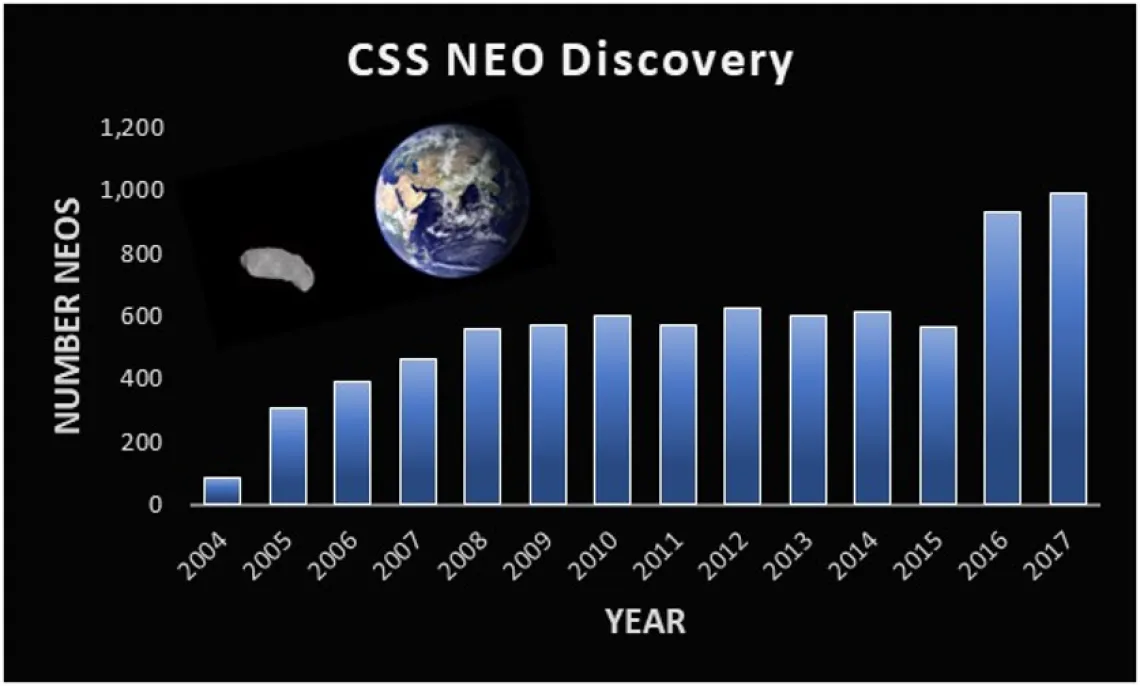Catalina Sky Survey Posts a Record Year of Near-Earth Asteroid Discovery in 2017

Catalina Sky Survey Posts Another Record Year of Near-Earth Object Discoveries
The University of Arizona’s Catalina Sky Survey (CSS) has done it again. With a total of 991 newly discovered Near-Earth Objects (NEOs) in 2017, CSS has surpassed their own record and again the all-time record for new NEO discoveries within a calendar year by a single survey program, this in a record year for the larger NEO survey community that collectively discovered more than 2000 NEOs. The NASA-funded Catalina Sky Survey has been a pioneer and leader in NEO surveying and discovery for two decades, and recent upgrades to hardware, software and survey strategies have pushed discoveries to these all-time records.
Near-Earth objects are mostly asteroids, and sometimes comets whose orbits bring them into Earth’s neighborhood. Fortunately, among the 17,700 plus NEOs that are currently known, none pose a significant impact threat to Earth, although over very long time spans, gravitational influences and other forces can potentially nudge some of these objects ever-closer to Earth’s orbit, and possibly onto a collision course. Additionally, there are many un-discovered NEOs of all sizes, hence the necessity for the Catalina Sky Survey.
Included within the 991 new CSS-discovered NEOs from 2017 are 180 asteroids larger than 140-meters (~450 feet) across, a size threshold mandated by NASA considering the potential damage a space rock of this size could inflict if it impacted. Also included in the year’s haul of NEOs are 44 Potentially Hazardous Asteroids (PHAs) which are larger than 140-meters across and whose orbit can bring them within 20 times the Earth-Moon distance; a close call, cosmically speaking, and necessitating our continued monitoring. In addition to these potentially hazardous asteroids, several other CSS-discovered space rocks in 2017 deserve special mention and are compiled here as the Catalina Sky Surveys ‘2017 Best of Class’:
Biggest: Asteroids 2017 CH1 and 2017 ME are estimated to be over 900 meters across (> ½ mile wide). Also discovered are 38 additional asteroids > ¼ mile across, including 13 PHAs.
Smallest: Measuring in at a mere 1.4 meters across (< 5 feet), asteroid 2017 UL6 would easily fit in most people’s kitchens! Also discovered are 28 additional asteroids estimated to be less than 20 feet across.
Closest: On April 4, 2017 the 3- to 6-meter wide near-Earth asteroid 2017 GM grazed by Earth at a distance of only 16,000 kilometers (about10,000 miles) above the surface, well within the ring of man-made geosynchronous satellites that orbit our planet. Also discovered are 33 additional asteroids which passed between the Earth and moon, including 10 asteroids passing less than 1-tenth the Earth-moon distance.
Farthest: The orbit of near-Earth asteroid 2017 GM transports this space rock more than 530 million miles (858 million kilometers) from the sun, out beyond the orbit of Jupiter. However, it will take a few years for it to return to this distant point, since 2017 GM just grazed by Earth in April 2017 (see Closest above).
Loneliest: At an inclination of 69 degrees, the orbital plane of asteroid 2017 KQ34 is steeply inclined relative to Earth’s orbital plane. As such, 2017 KQ34 spends most of its time orbiting in the loneliest regions, high above or below the more-crowded central plane of the solar system. Also discovered are 12 additional near-Earth asteroids with orbital inclinations > 45 degrees relative to Earth’s orbital plane, including 2 PHAs.
Hottest: Passing only 7 million miles (~11 million kilometers) from the sun, near-Earth asteroid 2017 TC1 is 18 million miles closer the sun than the planet Mercury at its closest point. Temperatures on the sunward side of Mercury can reach a roiling 800F. No doubt daytime highs on 2017 TC1 are hotter still! Also discovered were an additional 12 sun-baked near-Earth asteroids whose orbits bring them closer to the sun than Mercury’s closest approach, including 2 PHAs.
Oddball: CSS discovered one (rather rare) near-Earth comet in 2017, Comet P/2017 Y3 (Leonard). Of the >17,800 currently known near-Earth objects, only 107 are comets; all the remainder being asteroids. Comet P/2017 Y3 is greater than 3 miles (5 kilometers) across, larger than the biggest asteroid discovered by CSS in 2017. However, it will likely take many-thousands to millions of years before this comet’s orbit evolves to become either an increased Earth-impact threat, or no threat at all.
The success of Catalina Sky Survey has not gone un-noticed as NASA’s Planetary Defense Coordination Office and its subsidiary Near-Earth Object Observation program have recently awarded CSS a 3-year, $7 million grant. This grant extends CSS’s survey operations for 3 additional years and allows for further telescope hardware, software and infrastructure improvements that will surely add to discovery success. Additionally, CSS looks to add additional full-time observers, enabling them to keep more eyes on the night skies, keeping us here on Earth informed about, and safer from near-Earth asteroids.



